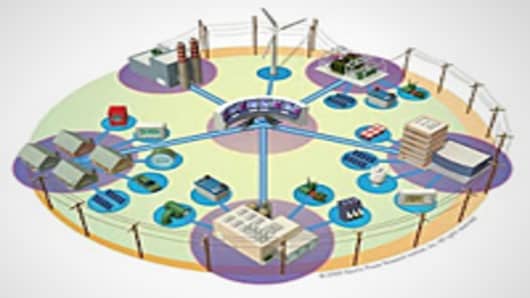The greenest power plant of the future may be one that is already built and can be found in many communities.
Virtual power plants, VPPs, are clusters of small, distributed energy sources across a certain area — whether it’s rooftop solar panels, small wind farms, fuel cells or even back-up generators that are idle most of the time — that are yoked together via software and operated as a single power plant.
“They’re operated like a 24-hour power plant, like a coal plant,” says Peter Asmus, VPP analyst at cleantech research firm Pike Research.
While each component may have limited capacity based on size or fuel — like solar panels, which can generate only during daylight — together they can put out a higher sum of energy around the clock, like a regular power plant.
Since the assets are built already and connected to the power grid, less capital is tied up building a new power plant.
These flexible power plants will be an important source of power generation in the coming years, says John Simmins, senior project manager for smart grid demonstration projects at the Electric Power Research Institute, EPRI, an independent research lab for the power industry.
Simmins, whose organization is working with the utilityAmerican Power Company on VPP concepts, says “you’re going to see these become ubiquitous in the next 5-10 years.”
Pike’s Asmus adds the “ultimate goal of the VPP” will be to combine far-flung, smaller power sources — like backup generators, geothermal systems and commercial rooftop solar panels —with aggressive power consumption management.
In the U.S., that power management typically comes from demand response systems, where a big power user, like a manufacturing facility, will tailor its power use depending on power prices and overall power demand in their region.
This will tie dispersed power sources in a small region together with the region’s power consumers in a microgrid, a single power system that lets them share energy resources “to squeeze out more value” from the region’s combined power assets, says Ausmus.
Demand response programs help power-consuming clients update their infrastructure and systems and schedule their power usage more effectively during the day, trimming their power bills significantly.
Though each VPP can look very different from the next, depending on the assets tied together in each plant, there are two basic models in operation today — so-called North American and European models.
North American VPPs are demand-driven, with a heavier focus on those assets within the VPP that can turn down their power demand at critical times and allow other parts of the “plant” to use this power capacity.
This is due to the demand-response market being more mature in the U.S., where firms like EnerNOC and Constellation Energy are active in this area.
The European model is supply-driven and focused on renewable energy, since the continent has large-scale intermittent power resources in wind and solar energy.
In Europe, research into supporting technologies focuses on areas like power storage to address intermittency.
Whichever model is used, Pike Research puts the global market for VPPs at $6.5 billion by 2017, with a capacity of about 80-105 gigawatts in power, the equivalent of over 100 typical natural gas-powered power plants, without the massive capital outlay to build those plants.
Software Holds The Key
But the biggest issue facing expansion of the VPP market isn’t economics, it’s software.
For a VPP to work, it’s critical to get the various assets that are tied together to talk to each other.
That's because equipment as varied as manufacturing systems that can be turned off at peak times, geothermal heat pumps used as on-site power generation, and next-generation battery and building automation technologies all use different operating systems and different controls.
“It’s not optimal to send different instructions to different systems by different vendors,” says EPRI’s Simmins. “They should all be speaking the same language.”
Assets “currently in the field often do not support any communication standards,” says Dr. Thomas Werner of the smart grid division at controls and equipment giant Siemens AG. “Hence the integration into a VPP can be laborious and expensive.”
Research is happening in this area, and Simmins points to similar protocol agreements that have revolutionized other industries, like consumer electronics and the Internet.
Other Obstacles
Another stumbling block is utilities, many of which have effective monopolies in their markets.
Utilities haven’t warmed to the idea of VPPs across the board, says Pike’s Asmus, since ultimately it means less power consumption and lower revenue for them.
He adds that in some jurisdictions, like California, regulators have decoupled utility profits from power sales, giving them better incentives to promote the kind of energy efficiency offered by VPPs.
Cooperation needed between utilities and regulators to spur the kind of resource use that would unlock these “lost” megawatts has been lacking, says Asmus.
“There hasn’t been enough of it,” he says.
“The legal and regulation framework in the energy market can be (an) obstacle,” says Siemens’ Werner. “In general, the implementation of a VPP in a liberalized (power) market requires setting up complex business processes.”
But these regulatory issues will likely get sorted out as more potential VPP assets are identified and built for their owners’ original purposes, be it backup power or green energy goals.
Werner adds that he expects small-scale renewable projects to blossom as VPPs become more tested.
While cheaper energy costs and environmental benefits may have driven companies’ initial investment in solar panels or geothermal systems, with a VPP these owners will now have a place to sell their excess green power, too.
So the growth of renewable energy will enable more VPPs, and vice versa.
“This will spur the growth of distributed generation,” he says. “VPPs provide new market opportunities for [these] resources.”


